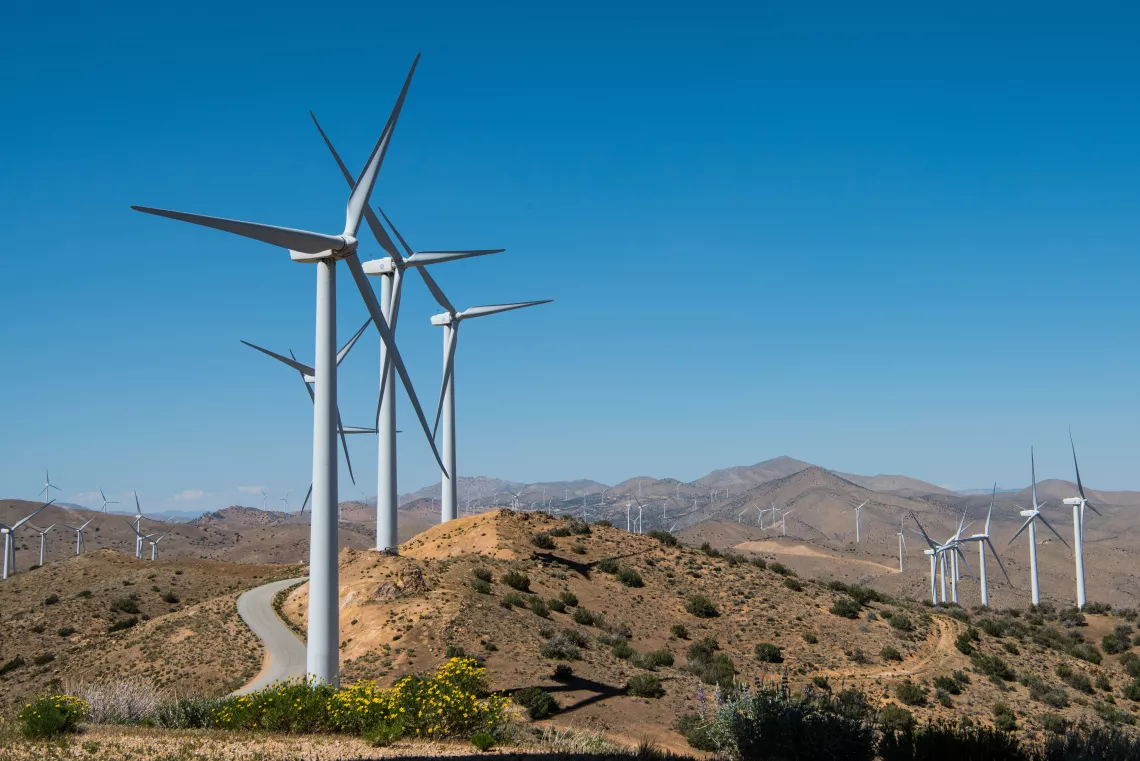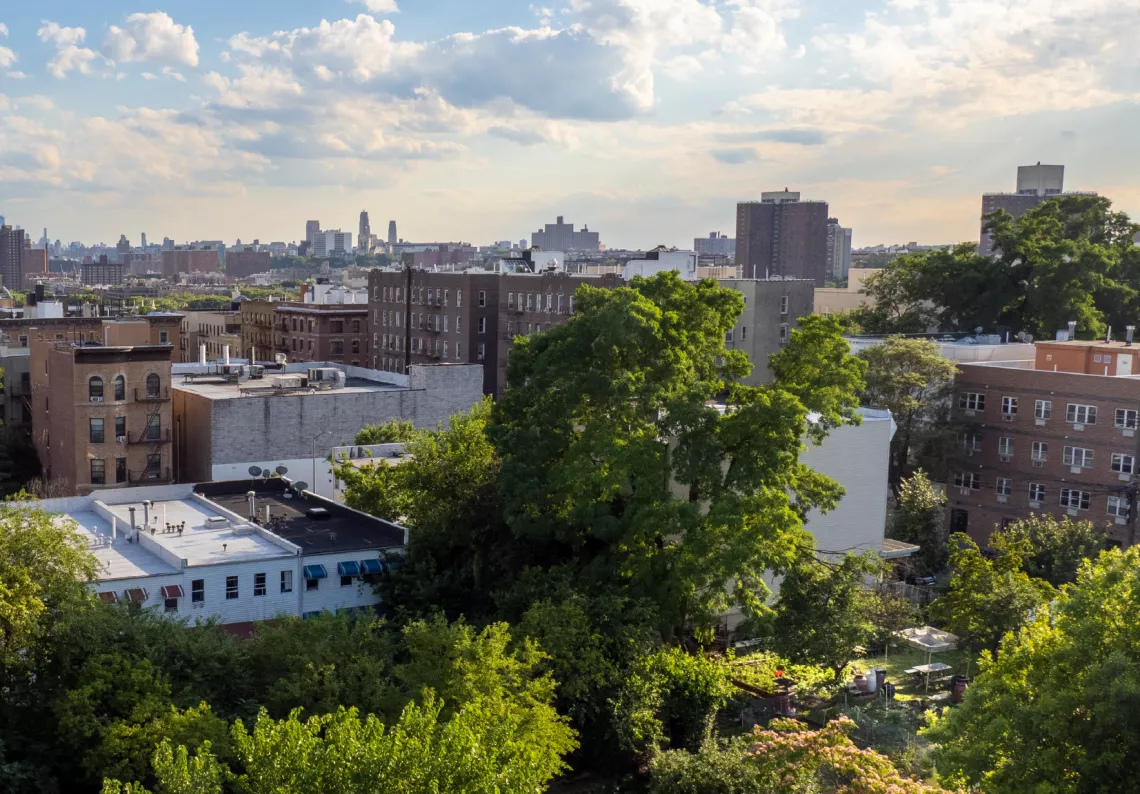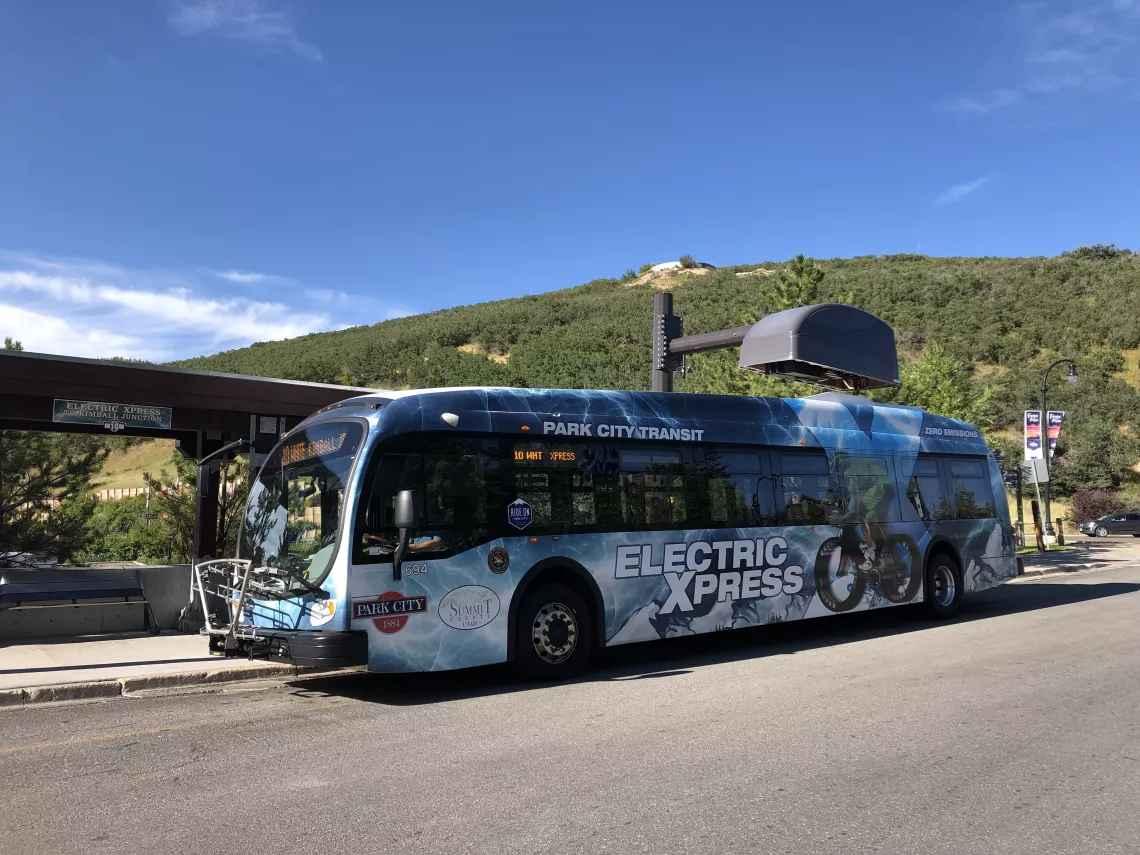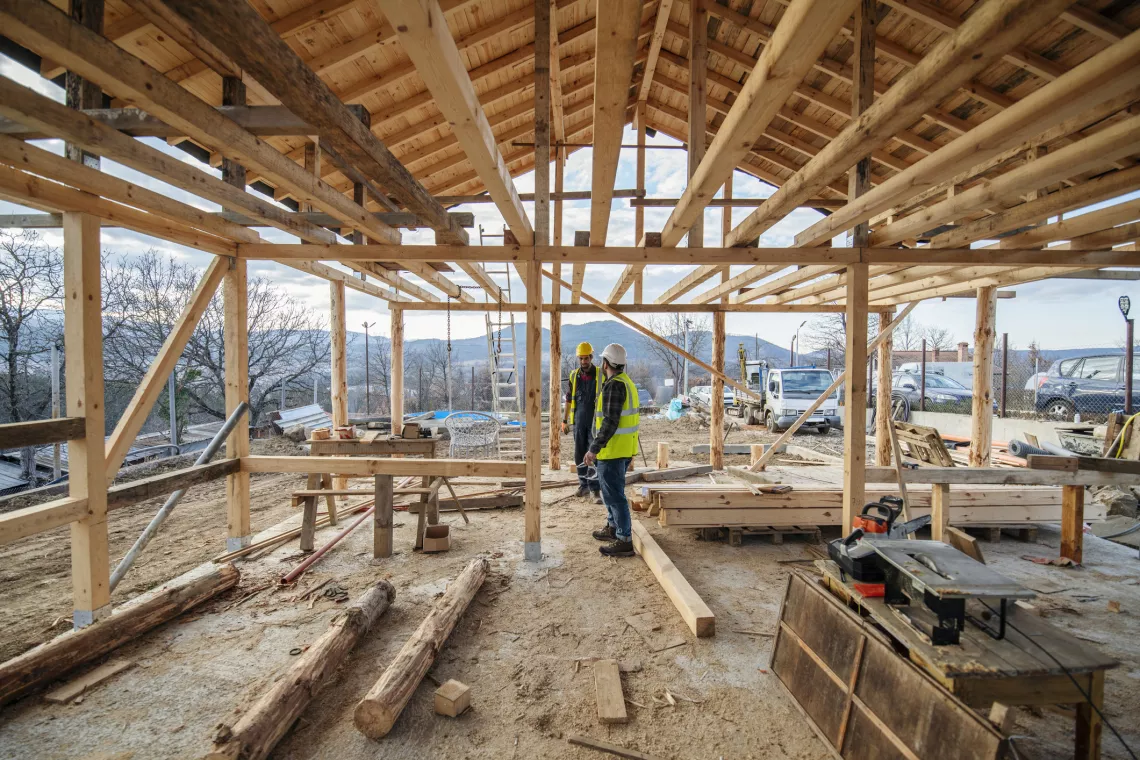Cities and Towns Can Reach Clean Energy Goals Thanks to the IRA
Cities and Towns Can Reach Clean Energy Goals Thanks to the IRA
The Inflation Reduction Act of 2022 includes programs and investments for towns and cities, not just for states. Here you can find information about the new programs local leaders can apply to that will help their cities and towns reach their climate goals.
Implementation information is up-to-date as of October 2023. Local leaders interested in any of these programs should check with the relevant government agency.
Note: Many of these programs require applicants to have active SAM.gov and Grants.gov registrations. Please consider applying as soon as possible, as applications can take months to process. Additionally, many of these programs are still being rolled out. If the agency offers it, consider signing up for updates so you don’t miss out on these critical funding opportunities.
Air Quality and Greenhouse Gas (GHG) Reduction Programs

Clean Electricity Investment and Production Tax Credits
What is it: For the first time, cities can get a check from the federal government to pay for clean energy. Local governments can choose either an investment or production tax credit for all wind and solar projects. Battery projects are eligible for the investment credit only. Special rules apply for other forms of clean energy (e.g., geothermal).
The base investment tax credit, if labor requirements are met, is 30% of a project’s cost. The base production tax credit, if labor requirements are met, is 0.3 cents per kWh (or approximately $26 per megawatt-hour (MWh) in 2022 dollars for producing clean electricity.
The baseline investment and production credits increase by 10% if certain domestic manufacturing requirements are met, and another 10% if the project is located in an energy community as defined in the IRA. An updated map of eligible communities is available here. If both conditions are met, the credit increases by 20%.
Who is eligible: All local governments are eligible.
Mechanism: The benefit is in the form of tax credits. Cities, counties, other local governments, school districts, and universities are eligible for direct payments of comparable value to tax credits for for-profit entities. More information about direct payments for clean energy is available here. For more information about direct payments for clean energy, see the National League of Cities website.
Timeframe for next steps: Projects that start construction between 2022 through 2032 or longer if a defined GHG target is not met are eligible.
Low-Income Communities Bonus Investment Tax Credit for Small Solar and Wind
What is it: For solar and wind projects that are 5 MW or smaller, an increase of the investment tax credit of:
10% to the credit for a project located in a low-income community or on Indian Land; or
20% to the credit for a project that is part of qualified low-income residential building or part of a qualified low-income economic benefit project.
Unlike the 10% increases to the investment credit for “energy communities” and domestic manufacturing which have an unrestricted supply, there is a limited supply of bonus credits for low-income communities. The Treasury Department has published the funding opportunity for the 2023 allocation and will do so again for 2024 to allocate low-income communities bonus credits to specific projects totaling 1.8 GW of projects in each year. There is no allocation for years 2025 and beyond, though unused credits may be allocated in future years.
Who is eligible: Any entity that could qualify for the investment tax credit, including local governments. Local governments would receive payments from the U.S. Treasury of the same value as the tax credits available to for-profit entities.
Mechanism: Tax credit, though allocation must be approved by the Treasury Department, unlike other tax credits. Through direct payment, cities, counties, other local governments, school districts, and universities are eligible for payments of comparable value as the tax credits available to for-profit entities.
Timeframe for next steps: The Department of Energy will be working in partnership with the Treasury Department and the Internal Revenue Service to evaluate applications starting October 19, 2023. For the 2023 allocation of credits, DOE is accepting applications on a rolling basis through early 2024. Further guidance can be found here.
Climate Pollution Reduction Grants
What is it: Grants for planning and implementation of programs that reduce greenhouse gas emissions.
Who is eligible: States, certain metropolitan areas, and Tribal governments.
Mechanism: Grants.
Timeframe for next steps: Planning grants and awards were made in summer 2023. Metro areas that received planning grants must submit Priority Climate Action Plans by March 1, 2024. Implementation grant applications will be due on April 1, 2024 for local governments that received a planning grant. Sample application materials and more information is available on EPA’s website.
GHG Reduction Fund
What is it: Grants to establish or expand financial institutions, like green banks and community development financial institutions, that support GHG-reduction and zero-emission projects with low-cost loans and other financing, and grants to establish Solar for All programs.
Who is eligible: State and local governments and non-profit financial institutions, like green banks and community development financial institutions, that meet certain eligibility requirements.
Mechanism: Grants and loans. In October 2023, EPA completed three competitions to distribute grant funding:
$7 billion Solar for All competition; local governments are directly eligible for the Solar for All funding only
$14 billion National Clean Investment Fund competition that will fund two to three national nonprofit financial institutions;
$6 billion Clean Communities Investment Accelerator competition that will fund two to seven hub nonprofit financial institutions;
Timeframe for next steps: EPA expects to make awards by July 2024, and implementation of these programs will extend for years after awards are made. More information is available on EPA’s website.
Environmental and Climate Justice Community Change Grants
What is it: Grants for community-led air pollution reduction initiatives, investments in climate resilience, reducing health risks from climate impacts, GHG emissions reduction, improving indoor air quality, and engaging disadvantaged communities.
Who is eligible: A coalition of at least two community-based non-profit organizations, including partnerships with local and Tribal governments and universities.
Mechanism: Grants. More information for applying here.
Timeframe for next steps: EPA has announced $2 billion in grant opportunities will be posted by November 2023. Applications will be accepted on a rolling basis for one year after the funding notice is published. Other information is available on EPA’s website, and more information and resources to develop project ideas and applications can be found here.
Air Pollution Monitoring & Screening
What is it: Grants to install and maintain air quality monitoring equipment.
Who is eligible: State, local, and Tribal governments; regional air pollution agencies; schools and school districts in low-income and disadvantaged communities.
Mechanism: Grants. More information for applying here.
Timeframe for next steps: Funding and other information is available on EPA’s website.
Grants to Reduce Air Pollution at Ports
What is it: Competitive grants and rebates to finance zero-emission port equipment and technology to reduce air pollution and GHGs from U.S. port operations.
Who is eligible: Ports and state, regional, local, and Tribal governments with jurisdiction over ports; air pollution control agencies, or a non-profit organization that partners with one of the aforementioned entities or operates or owns related port technologies.
Mechanism: Grants. More information for applying here – you can also sign up to receive updates.
Timeframe for next steps: Funding must be dispersed by September 2027. Funding opportunities and other information will be available on EPA’s website.
Neighborhood Access and Equity Grant Program
What is it: Competitive grants to reconnect communities that have been divided by existing transportation infrastructure barriers, to reduce the impacts of transportation facilities or construction projects on disadvantaged or underserved communities, and to support equitable transportation planning and community engagement activities.
Who is eligible: State and local governments, metro planning organizations.
Mechanism: Grants.
Timeframe for next steps: This program is still in the planning stages, and EPA will update this webpage with more information once available.
Energy Improvements in Rural or Remote Areas (IIJA)
What is it? IIJA provides $1 billion in financial investment, technical assistance, and resources to advance clean energy demonstrations and energy solutions in communities with less than 10,000 people.
Who is eligible? Industry Partners and other or-profit entities; utilities; institutions of higher education; state and local governments; community based organizations and other non-profit Entities; Tribal; environmental groups; and cities, towns, or unincorporated areas with populations of fewer than 10,000 inhabitants.
Mechanism? Grants and cooperative agreements.
Timeframe for next steps? Full applications were due October 2023, and the next round is expected in mid-2024. More information is available on DOE's website.
Energy Efficiency and Conservation Block Grant (EECBG) Program
What is it? This program is administered by the Department of Energy and addresses sustainability priorities through actions such as improving transportation infrastructure, adopting and implementing building energy codes, strengthening electric grid policy and program making, and supporting community-driven climate and resilience planning. Total funding available is $550,000,000, and awards are to be made on an ongoing basis until funds are exhausted.
Who is eligible? Funding is available from the formula grants to smaller communities through application to their state. States are required to pass 60% of their funding to these smaller communities. Large cities and counties can apply directly for competitive grants.
Mechanism? Formula and competitive grants.
Timeframe for next steps? The next funding deadline for local and tribal governments is April 30, 2024. View more details at the Department of Energy homepage here. Past awardees of the Competitive Program were selected on October 12, 2023. View competitive grant recipients here. Formula Grant awardees can be viewed here. A related program, placing DOE “Community Energy Fellows” with tribes and local governments, is open for host applications from formula-eligible governments through March 31, 2024, see details here.
Latest and Zero Building Energy Codes
What is it? DOE administers the program, totaling up to $1 billion in technical assistance competitive grants available for the adoption and implementation of the latest model energy codes, zero energy codes, building performance standards, and innovative codes that achieve equivalent energy savings to the latest model and zero energy codes.
Who is eligible? Local governments that have the authority to adopt building codes.
Mechanism? Competitive grants.
Timeframe for next steps? Informational Webinar to be hosted January 17, 2024 11:00 AM PST, register here. Concept paper is required by February 9, 2024, with the full application due April 30, 2024. See details for the funding announcement here.
Energy Improvements at Public K-12 School Facilities
What is it? DOE is providing $500 million for the Renew America’s Schools Program to implement clean energy improvements in K-12 public schools across the country. The program is intended to help schools upgrade energy systems that will ultimately lower utility costs, improve indoor air quality and foster healthier learning environments.
Who is eligible? Local agencies governing school districts and operations.
Mechanism? Competitive grant program.
Timeframe for next steps? The DOE announced selections for Round 1 of funding on June 29, 2023. The second round of funding opportunities is anticipated in Spring 2024.
Climate Resilience Programs

Building Resilient Infrastructure and Communities
What is it? Building Resilient Infrastructure and Communities (BRIC) supports projects that undertake hazard mitigation projects, reducing the risks they face from disasters and natural hazards. The program’s guiding principles are supporting communities through capability and capacity building; encouraging and enabling innovation; promoting partnerships; enabling large infrastructure projects; maintaining flexibility; and providing consistency.
Who is eligible? State, territory and Tribal governments.
Mechanism? The Safe Streets for All program funds regional, local and Tribal initiatives and projects.
Timeframe for next steps? The application period for FY2023 is currently open until February 29, 2024. This grant cycle includes funding for projects for flood mitigation assistance and building resilient infrastructure and communities.
Urban and Community Forestry Assistance Program
What is it: Competitive grants for tree planting projects that prioritize underserved populations and areas.
Who is eligible: State, local, and Tribal governments or nonprofits.
Mechanism: Grants: check the Forest Service’s Urban and Community Forest Program webpage or contact your state coordinator for more information.
Timeframe for next steps: One funding opportunity closed in summer 2023, and other funding opportunities are expected.
Investing in Coastal Communities and Climate Resilience
What is it: Competitive grants and direct investments to support coastal community preparation for extreme weather, restore and protect coastal and marine resources, and support natural resources that sustain coastal- and marine-dependent communities.
Who is eligible: Coastal and Great Lakes states, local and Tribal governments, nonprofits, and universities.
Mechanism: Grants: Check NOAA’s Inflation Reduction Act webpage for updates.
Timeframe for next steps: Not specified.
Reclamation Domestic Water Supply Projects
What is it: Grants and financial assistance for disadvantaged communities to supply domestic water to “communities or households that do not have reliable access to domestic water supplies.”
Who is eligible: Not specified but will likely include local drinking suppliers.
Mechanism: Grants: Information on the program will be available on the Bureau of Reclamation’s Inflation Reduction Act webpage. Sign up here to receive notifications.
Timeframe for next steps: Not specified.
Drought Mitigation in the Reclamation States
What is it: Grants to public entities for water conservation, drought prevention, and habitat restoration (to mitigate the effects of drought) in the “reclamation states.”
Who is eligible: Public entities in AZ, CA, CO, ID, KS, MT, NE, NM, NV, ND, OK, OR, SD, UT, WA, and WY.
Mechanism: Grants: Information on the program will be available on Reclamation’s Inflation Reduction Act webpage. Sign up here to receive notifications.
Timeframe for next steps: Not specified.
Thriving Communities Program (IIJA)
What is it? Thriving Communities Program provides technical assistance, planning, and capacity building support to teams of community partners that may lack the staffing or technical expertise to scope, fund, and develop infrastructure projects that advance broader community goals. TCP will provide two years of deep-dive assistance and three years of facilitated peer learning support to selected communities–particularly those disproportionately impacted by environmental, climate, and human health outcomes–to help them plan and develop a pipeline of comprehensive transportation, housing, and community revitalization activities.
Who is eligible? Capacity builders program: non-profit organizations, philanthropic organizations, and other technical assistance providers, including academic institutions. Regional Pilot Program: state governments and agencies, local governments and agencies, Indian tribes, planning organizations at the regional or metropolitan level, regional/statewide/tribal level planning non-profit organizations.
Mechanism? Grants. The funding is split between the Capacity Builder Program for non-profits, philanthropic entities, and other private sector groups, and the Regional Pilot Program for state, Tribal, and regional governments and their agencies as well as statewide, Tribal or regional planning non-profit organizations. Selected entities provide technical assistance, planning, and capacity building to communities across the country (Capacity Builder Program) or to communities within their state/region (Regional Pilot Program).
Timeframe for next steps? The program was open until November 28, 2023. Learn more here.
Flood Mitigation Program
What is it? This program provides funding to reduce or eliminate the risk of repetitive flood damage to buildings insured by the National Flood Insurance Program.
Who is eligible? State, local, Tribal and US Territory governments that have developed and adopted hazard mitigation plans.
Mechanism? This program is a competitive grant program.
Timeframe for next steps? The application period for FY2023 is open until February 29, 2024.
Clean Transportation Programs

Clean School Bus Program
What is it: Grants and rebates made possible through the Infrastructure Investment and Jobs Act to replace existing diesel school buses with zero-emission or clean school buses.
Who is eligible: State, local, and Tribal governments, public charter school districts, and certain school transportation contractors.
Mechanism: Grants and rebates. 2023 - 2024 rebates process: information on the program will be available on EPA’s webpage. Sign up here to receive notifications.
Timeframe for next steps: EPA will award $500 million in rebates with an application deadline of January 31, 2024.
Clean Heavy-Duty Vehicles
What is it: Grants and rebates for the incremental cost of purchasing zero-emission heavy-duty vehicles and installing the infrastructure to charge/fuel the vehicles.
Who is eligible: State, local, and Tribal governments, school districts, and school transportation authorities.
Mechanism: Grants: The EPA will be offering grants and rebates to eligible recipients. Submit your contact information here to be notified when funding opportunities are available.
Timeframe for next steps: Funding and other information is available on EPA’s website.
Commercial Clean Vehicles
What is it: A tax credit for commercial purchase of electric or other zero-emission vehicles.
Who is eligible: Businesses and non-tax paying entities, including municipalities.
Mechanism: Tax credits: Find out more about eligibility for new clean vehicles and used clean vehicles. You can claim the clean vehicle credit with this IRS form.
Timeframe for next steps: Available starting in 2023.
Tax Credit for Alternative Refueling Property
What is it: A tax credit for electric vehicle charging and alternative fuel infrastructure installed in low-income or rural census tracts.
Who is eligible: Businesses, individuals, and non-tax paying entities, including municipalities.
Mechanism: Tax credits: Information on eligibility and IRS forms can be found on this IRS webpage.
Timeframe for next steps: Available starting in 2023.
Charging and Fueling Infrastructure Discretionary Grant Program (IIJA)
What is it? The IIJA designates $2.5 billion toward the deployment of electric vehicle charging and alternative fuel infrastructure where people live and work and along alternative fuel corridors. Two categories of grants are available: Community Charging and Fueling Grants and Alternative Fuel Corridor Grants.
Who is eligible? States, metropolitan planning organizations, units of local governments, special purpose districts or public authorities with a transportation function, including port authorities, Tribes, U.S. territories, authorities/agencies owned by state and local governments, and state or local authorities with ownership of publicly accessible transportation facilities.
Mechanism? Grants: applications expected to re-open in early 2024. Visit the program website for more updates. DOT will fund 80% of project costs.
Timeframe for next steps? Not specified.
Low-No Emission Bus and Bus Facilities
What is it? The Federal Transit Administration facilitates the Bus and Bus Facilities program. This is a federal resource available to replace, rehabilitate and purchase transit buses and related equipment, and to construct bus-related facilities. The funds are also regularly used for purchase of low and no emission buses, including electric transit buses.
Who is eligible? Designated recipients, such as Transit Agencies, that allocate funds for fixed-route bus operators, States, local and Tribal government entities that operate fixed route bus service.
Mechanism? Competitive grants and formula funding.
Timeframe for next steps? The FTA announced FY2023 awards on June 26th. Announcements of funding opportunities are anticipated in FY2024 once Congress has finalized a FY 2024 budget.
Safe Streets for All
What is it? $5 billion was appropriated by the Bipartisan Infrastructure Law for the Safe Streets for All to be distributed through grants for projects that prevent roadway deaths and serious injuries. $1 billion of funding is appropriated and distributed each year from 2022-2026.
Who is eligible? The Safe Streets for All program funds regional, local and Tribal initiatives and projects.
Mechanism? This program is a competitive grant program.
Timeframe for next steps? $813 million was awarded to 385 communities on December 13, 2023. Applications for FY2024 grants are anticipated to open in February 2024.
Strengthening Mobility and Revolutionizing Transportation Grants Program
What is it? The Strengthening Mobility and Revolutionizing Transportation (SMART) Grant program was designed as a $500 million discretionary grant program for eligible public sector agencies to conduct demonstration projects focused on advancing community technologies and systems that improve efficiency and safety. Funding is distributed in $100 million increments on an annual basis during FY2022-26.
Who is eligible? State and subdivision of states, tribal governments, public transit agencies, public toll authorities, metropolitan planning organizations or any combination of above entities.
Mechanism? The SMART program is a competitive grant program.
Timeframe for next steps? The FY23 application opportunity closed on October 10th, 2023, with a new funding round anticipated for FY24. Award announcements are anticipated for early 2024.
Rural Surface Transportation Grant
What is it? The Rural Surface Transportation grant program funds projects that improve and expand surface transportation infrastructure in rural areas. Eligible projects include highways, bridges, tunnels, freight projects and safety improvement infrastructure. Projects should help improve the safety and reliability of the movement of people and freight, and generate economic growth.
Who is eligible? States, regional transportation planning organizations, units of local governments, Tribal governments or any combination of the entities.
Mechanism? This is a competitive grant program.
Timeframe for next steps? FY2023 and FY2024 grant awards were announced in December, 2023.
Mega Grant Program (National Infrastructure Project Assistance program)
What is it? The Mega Program (the National Infrastructure Project Assistance program) supports large, complex projects that are difficult to fund by other means and likely to generate national or regional economic, mobility, or safety benefits.
Who is eligible? State or a group of states, metropolitan planning organizations, local or Tribal governments, special purpose districts with a transportation function, Amtrak in partnership with one or more entities previously listed, and any combination of those entities.
Mechanism? This program is a competitive grant.
Timeframe for next steps? Awards were most recently announced in 2022.
Buy Clean Programs

Grants for Environmental Product Declaration and Other Labels
What is it: As part of the federal government’s preferential purchase of environmentally friendly products (“Buy Clean”), the EPA is helping manufacturers of construction materials calculate their products’ carbon footprint. Local governments can use the resources made available to also encourage their suppliers to produce a summary of their carbon footprint, called an Environmental Product Declaration (EPD). In addition, local governments can use EPA resources to support the design of procurement policies that integrate this data.
With EPDs in place, local governments can initiate their own preferential purchasing programs that encourage industry to decarbonize and to reduce other toxic pollution releases. These local initiatives could amplify existing federal programs and bolster (or help initiate) parallel measures at a state level.
Who is eligible: Manufacturers of construction materials or states/Tribes/nonprofits that assist in measuring, reporting, verifying, and implementing policies that steadily reduce the quantity of embodied carbon of construction materials and products.
Mechanism: The EPA will be offering grants and technical assistance to eligible recipients.
Time frame for next steps: The EPA will begin issuing grants in the first quarter of 2024. The resources will be allocated according to the following schedules:
EPA anticipates awarding up to 40 grants and cooperative agreements that total $100 million in fiscal year 2024.
The EPA has until Sept. 30, 2031, to spend $250 million in technical assistance to businesses in measuring and reporting the quantity of carbon emissions in construction materials and products.
The EPA, in consultation with the Federal Highway Administration, has until Sept. 26, 2026, to create labels for construction materials for transportation projects.